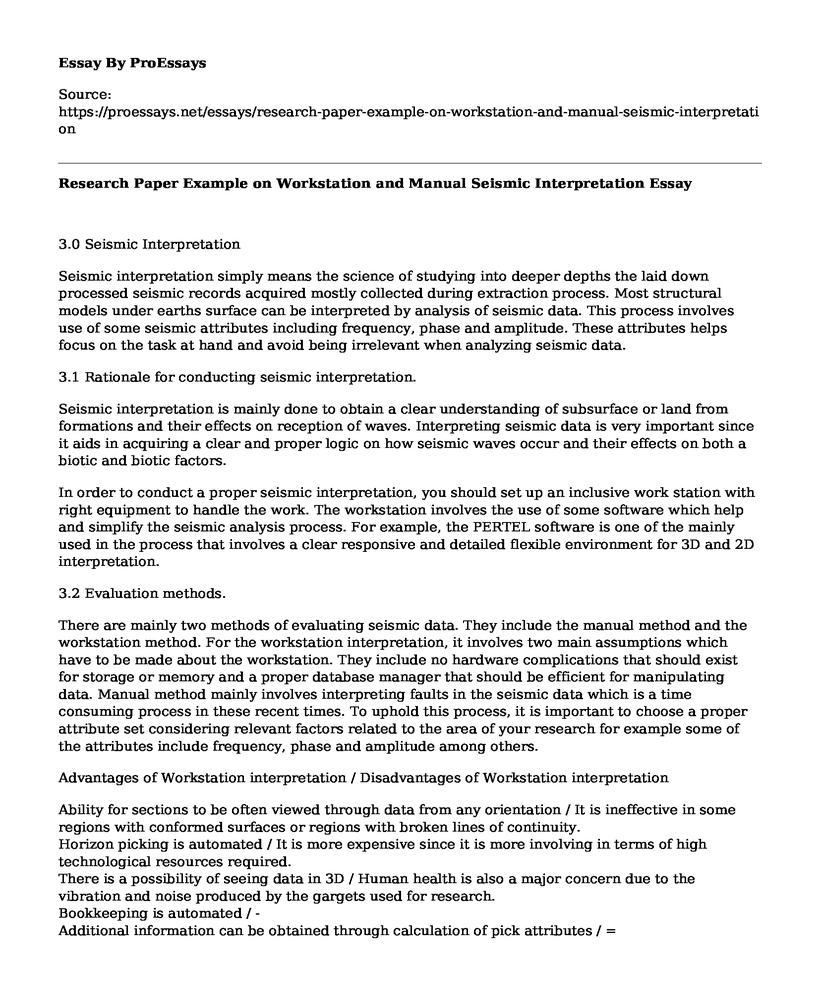3.0 Seismic Interpretation
Seismic interpretation simply means the science of studying into deeper depths the laid down processed seismic records acquired mostly collected during extraction process. Most structural models under earths surface can be interpreted by analysis of seismic data. This process involves use of some seismic attributes including frequency, phase and amplitude. These attributes helps focus on the task at hand and avoid being irrelevant when analyzing seismic data.
3.1 Rationale for conducting seismic interpretation.
Seismic interpretation is mainly done to obtain a clear understanding of subsurface or land from formations and their effects on reception of waves. Interpreting seismic data is very important since it aids in acquiring a clear and proper logic on how seismic waves occur and their effects on both a biotic and biotic factors.
In order to conduct a proper seismic interpretation, you should set up an inclusive work station with right equipment to handle the work. The workstation involves the use of some software which help and simplify the seismic analysis process. For example, the PERTEL software is one of the mainly used in the process that involves a clear responsive and detailed flexible environment for 3D and 2D interpretation.
3.2 Evaluation methods.
There are mainly two methods of evaluating seismic data. They include the manual method and the workstation method. For the workstation interpretation, it involves two main assumptions which have to be made about the workstation. They include no hardware complications that should exist for storage or memory and a proper database manager that should be efficient for manipulating data. Manual method mainly involves interpreting faults in the seismic data which is a time consuming process in these recent times. To uphold this process, it is important to choose a proper attribute set considering relevant factors related to the area of your research for example some of the attributes include frequency, phase and amplitude among others.
Advantages of Workstation interpretation / Disadvantages of Workstation interpretation
Ability for sections to be often viewed through data from any orientation / It is ineffective in some regions with conformed surfaces or regions with broken lines of continuity.
Horizon picking is automated / It is more expensive since it is more involving in terms of high technological resources required.
There is a possibility of seeing data in 3D / Human health is also a major concern due to the vibration and noise produced by the gargets used for research.
Bookkeeping is automated / -
Additional information can be obtained through calculation of pick attributes / =
Advantages of Manual interpretation / Disadvantages of Manual interpretation
It is an alternative where there are broken lines of continuity. / No ability to view sections from any orientation
It is cheaper and less involving in terms of resources to use in the process. / No automation of horizon picking
- / Data is only viewed in 2D
- / Handy bookkeeping
- / Difficulty in obtaining additional information.
- / It is tedious and time-consuming due to horizon manual picking
The workstation interpretation method is the most preferred method to handle manipulation of seismic data. This is because this method has more advantages than the manual method which is more time consuming and tedious. In the workstation method, there is automation of book keeping which is more time saving counteracting the weakness of manual method.
3.3 Description of type and quality of data provided by the client
The client providing data obtained from several survey maps and a different number of short line helps determine the level of accuracy and reliability when conducting a project on seismic waves. From the data provided one is able to determine what are the possible source rock, cap rock and velocity among others. For example from the data provide, the possible source rock is Diyab formation and cap rock is formation Hith which are upper Jurassic formation belonging to the SILA group. The average velocity obtained is 3.15Km/s. Apart from above, the reservoir formation is referred to as the ARAB and its typical thickness is estimated to be between 17 meters to 30 meters. The average porosity is 26.5% and the average saturation recorded is 29.5%.
3.4 Observations and structures
The seismic horizons were easy to tract at some regions due to the strong, reliable reflectors showing that the data quality provided from the seismic interpretation workstation were relatively better. Manual interpretation was also applied to connect some horizons due to the broken lines. Some complications also arose. Broken reflectors, unconformities on the surfaces (for example the anticlines and the synclines) and a lot of noise produced during the process could have led to obtaining poor quality data. Due to absence of continuity lines in some horizons, manual interpretation could not be applicable. Increase in possibility in the disturbance can be as a result of presence of fractures and minor faults, errors and uncertainties in the data acquisition processes or methods.
Cite this page
Research Paper Example on Workstation and Manual Seismic Interpretation. (2021, Apr 06). Retrieved from https://proessays.net/essays/research-paper-example-on-workstation-and-manual-seismic-interpretation
If you are the original author of this essay and no longer wish to have it published on the ProEssays website, please click below to request its removal:
- Essay Example on Somalia, Its Government, Civil Society and Economic Environment
- Paper Example on Qatar History
- Research Paper Example: Skydiving and Science Advancement
- Essay Example on Ada Lovelace: Math & Computer Genius Before Her Time
- Paper Example on Engineering: Math & Science Solving Life's Problems
- Essay Example on Exploring Appalachia: A Region of Contrasts and Disadvantage
- Essay Example on 5 Top Nootropics: Caffeine, Creatine, Bacopa, L-Theanine, Rhodiola







